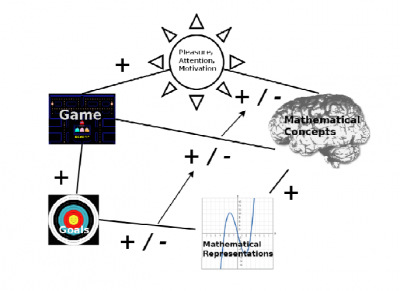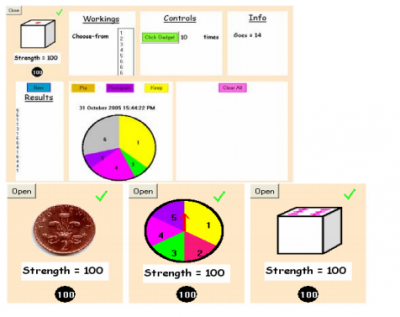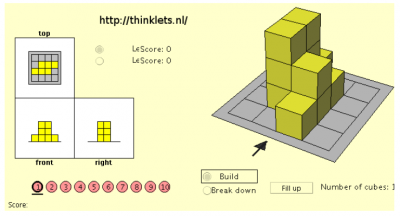Mathematical Game Pieces/OG
| Mathematical Game Pieces | |
| Contributors | Yishay Mor |
|---|---|
| Last modification | May 16, 2017 |
| Source | Mor (2008)[1] |
| Pattern formats | OPR Alexandrian |
| Usability | |
| Learning domain | |
| Stakeholders | |
Mathematical content is often injected artificially into games or other activities, as Sugar-Coating (Sugar-Coating). This has a dual effect of ruining the game and alienating the mathematics. By contrast, for many mathematicians, mathematics is the game.
The problem
How do you design (or choose) a game to convey mathematical ideas in an effective and motivating manner? How do you judge if a proposed game is an adequate tool for teaching particular mathematical concepts?
Forces
• A game used in education has to provide a good game experience, or else it is “just another boring task”.
• Learners need to engage with the mathematical content that the game aims to promote.
• The chosen representations need to be consistent both with the game metaphors and with the epistemic nature of the content domain.
Context
An educator wishing to use games as part of her teaching, either evaluating existing “educational” games, appropriating “entertainment” games, or designing and developing her own games.
A developer wishing to develop games for the educational market.
Solution
• Identify an element of the mathematical content you wish to address in this game.
• Find a visual, animated or tangible representation of this element which is consistent with the game metaphors.
• Design your game so that these objects have clear Purpose and Utility (Purpose and Utility) as game elements in the gameplay structure.
The objects representing the mathematical content should have a meaningful intrinsic role in the game. Manipulating these objects can be part of the game rules or goals, or understanding them could be a necessary condition for success.
If the game includes or is followed by communication between participants, then the mathematical game pieces should become Objects to Talk With (Objects to Talk With).
Examples
In Chancemaker[2] users manipulate the odds of various chance devices, such as dice and roulette wheels. The game pieces are representations of probability (Figure 2).
In Programming Building Blocks[3] the object of the game is to reconstruct a 3D shape from its 2D projections. The mathematical content is the focus of the game, and the objects used in the game are straightforward representations of that content (Figure 3).
Related Patterns
Used by: Objects to Talk With (Objects to Talk With).
Contradicts: Sugar-Coating (Sugar-Coating) (anti-pattern)
Elaborated by: Guess My X (Guess My X)
Notes
This is a very high level pattern which needs to be elaborated per specific game and content classes. For example, in a quest type game it might spawn different sub-patterns than in puzzle type games. Likewise, factual and procedural knowledge might lead to different strategies than meta-cognitive skills. Nevertheless, it is useful as a guideline for evaluating design proposals. Its absence marks a game as a weak tool for learning.
References
- ↑ Mor, Y. (2008). Guess my X and other Techno-pedagogical Patterns: Toward a Language of Patterns for Teaching and Learning Mathematics. In Proceedings of the 13th European Conference on Pattern Languages of Programs (EuroPLoP 2008). New York:ACM.
- ↑ Pratt, D. (1998). The co-ordination of meanings for randomness. For the learning of mathematics, 18(3), 2-11.
- ↑ http://www.thinklets.nl (broken link)


